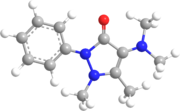

This article needs additional citations for verification. Please help improve this articlebyadding citations to reliable sources. Unsourced material may be challenged and removed.
Find sources: "Aminophenazone" – news · newspapers · books · scholar · JSTOR (March 2020) (Learn how and when to remove this message) |
 | |
 | |
| Clinical data | |
|---|---|
| AHFS/Drugs.com | International Drug Names |
| ATC code | |
| Pharmacokinetic data | |
| Metabolism | N-demethylation[1] |
| Identifiers | |
| |
| CAS Number |
|
| PubChem CID | |
| DrugBank |
|
| ChemSpider |
|
| UNII | |
| KEGG |
|
| ChEBI | |
| ChEMBL | |
| CompTox Dashboard (EPA) | |
| ECHA InfoCard | 100.000.332 |
| Chemical and physical data | |
| Formula | C13H17N3O |
| Molar mass | 231.299 g·mol−1 |
| 3D model (JSmol) | |
| |
| |
| (verify) | |
Aminophenazone (oraminopyrine, amidopyrine, Pyramidon) is a non-narcotic analgesic substance. It is a pyrazolone and a derivative of phenazone, which also has anti-inflammatory and antipyretic properties. While inexpensive and effective, especially in the treatment of rheumatism, the drug carries a serious risk of severe and sometimes fatal side-effects, including agranulocytosis.[citation needed] While its production and use have been banned in many countries, including France, Thailand, India and Japan, it is still sometimes used in the developing world.[citation needed]
A breath test with 13C-labeled aminopyrine has been used as a non-invasive measure of cytochrome P-450 metabolic activity in liver-function tests.[1] It is also used in measuring the total body water in the human body system.[2]
Aminophenazone was first synthesized by Friedrich Stolz and Ludwig Knorr in the late nineteenth century, and sold as an anti-fever medicine known as Pyramidon by Hoechst AG from 1897 until its eventual replacement[when?] by the safer propyphenazone molecule.
Symptoms of exposure to this compound include:[3]
Agranulocytosis often occurs. Ingestion may cause central nervous system stimulation, vomiting, convulsions, cyanosis, tinnitus, leukopenia, kidney damage and coma. Ingestion may also lead to nausea, mental disturbances, methemoglobinemia, chocolate-colored blood, dizziness, epigastric pain, difficulty in hearing, thready pulse and liver damage.
Other symptoms reported via ingestion include hemolytic anemia, porphyria and severe gastrointestinal bleeding. Bone marrow depression also occurs. Rare eye effects include acute transient myopia.
Chronic symptoms include:
When heated to decomposition this compound emits toxic fumes of nitrogen oxides.
Amidopyrine is metabolized by demethylation and acetylation. Amidopirina metabolites are 4-aminoantipyrine, metilaminoantipirin, rubazonovaya and metilrubazonovaya acid. These acids have a reddish color. At high amidopirine doses, urine can have a reddish brown coloration, due to the presence in the urine of these acid markers.[4]
Hospital Universitario Ramón y Cajal in Madrid, Spain was built as a center for specialized surgery, a panacea for the ills of the health system in Madrid. Locals hence nicknamed it el piramidón.[5]
De acuerdo con todo ello, el Ramón y Cajal comenzó a ser esperado como la gran panacea que tenía que resolver gran parte de los problemas hospitalarios madrileños. Por ello, alguien pensó que, siguiendo con los términos médicos, el citado centro venía a ser a la sanidad madrileña como el Piramidón -un antipirético muy utilizado para eliminar los síntomas de la enfermedad, aunque no la enfermedad en sí- a cualquier enfermo. De ahí a que el Centro Ramón y Cajal pasara ser conocido por todos como el Piramidón no medió ni un paso.
This analgesic-related article is a stub. You can help Wikipedia by expanding it. |